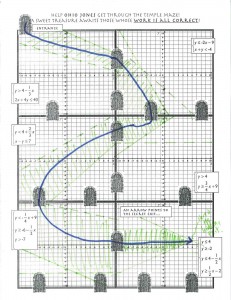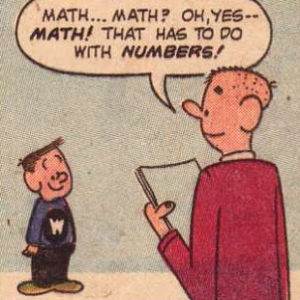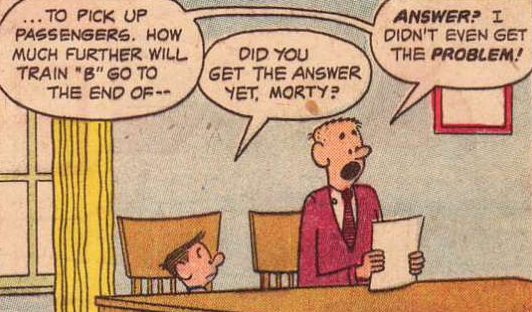I hate math. Do not even come near me with talk of logarithms, imaginary numbers, or cosines. Making my way through math classes was like a miserable walk up a hill on a muggy, bug-infested day. Even now, the only math problems I can wrap my head around are story problems. Give me a narrative and I’ll give you your awful cosine. But textbooks never did that, did they? Which of these two would you rather answer?
A) Gertrude the Dwarf must carve a tunnel through the mountain to create a trail for gold mining. In an effort to determine the length of the tunnel, Gertrude must first walk 7000m from her dwelling to a central point where she can see both her home and the enchanted waterfall on the other side of the mountain. From that point, she measures 0.50 radians between the two locations. Lastly, she walks 6000m to the waterfall.
What is the length of the tunnel?
or
B) 82 = 92 + 52 − 2 × 9 × 5 × cos(C)
Egads, is all I have to say to that Option B. EGADS.
There is a school of thought that Option A may be the better approach for most students. One blog by the name of The Exponential Curve often converts horrible numbered equations into word problems via comic strips. The steps of the equations are worked out panel-by-panel with sweet, black and white, penciled characters working out how to solve the problems.
 The Exponential Curve is run by Dan Wekselgreene, a math teacher working with high-schoolers. The mathematical disciplines covered are Algebra I, Algebra II, and Numeracy. Offerings include worksheets, lesson plans, tests, review activities, and involved discussions on teaching strategies. The comic strips were actually created as part of a review project he assigned to his students.
The Exponential Curve is run by Dan Wekselgreene, a math teacher working with high-schoolers. The mathematical disciplines covered are Algebra I, Algebra II, and Numeracy. Offerings include worksheets, lesson plans, tests, review activities, and involved discussions on teaching strategies. The comic strips were actually created as part of a review project he assigned to his students.
There are dozens of other math class projects posted online to peruse, as well as a plethora of studies focused on the usage of comic books as a math teaching tool. Tin Lam Toh, a math professor at the National Institute of Education Singapore, wrote The Use of Cartoons and Comics to Teach Algebra in Mathematics Classrooms. It’s an informative read on the efficacy of comics in illustrating numerical principles to students. Toh states that
The teachers [said] that, through using cartoons and comics to introduce algebra, the students were less resistant to learning algebra. The teachers were able to engage more students to learn more challenging algebra (such as communicating in algebra language), involved in the addition and subtraction of algebraic expressions. By engaging the students to draw cartoons and comic strips in the process of learning algebra, the under-achieving students were more willing to participate in the lessons through creating their own cartoons and infusing the algebraic language. The language of algebra also becomes more natural to them.
Toh also encourages teachers to have students depict equations through drawing. By seeing a physical representation of how students interpret the math problems, teachers are able to see if they are fully comprehending the material or if there is a misunderstanding. Toh explains that
Observant classroom teachers could make use of students’ work to pre-empt the students’ misconceptions of algebraic objects, so as to better prepare their subsequent algebra lessons.
Both teachers and students transferring math concepts to a comic format increases understanding of the topic and opens up a dialogue for the teacher to address misconceptions for kids that are struggling.
For those interested in teaching and/or learning using this strategy, the New-To-Teaching blog offers instructions on how to facilitate the comic strip approach. An additional free resource is available from the Kennedy Center Arts Edge program, with a comic template accompanied with a tutorial on how to “Weave words and pictures together in a comic strip format to convey nonfiction information” Cheers to spreading word problems with the power of comic books.




